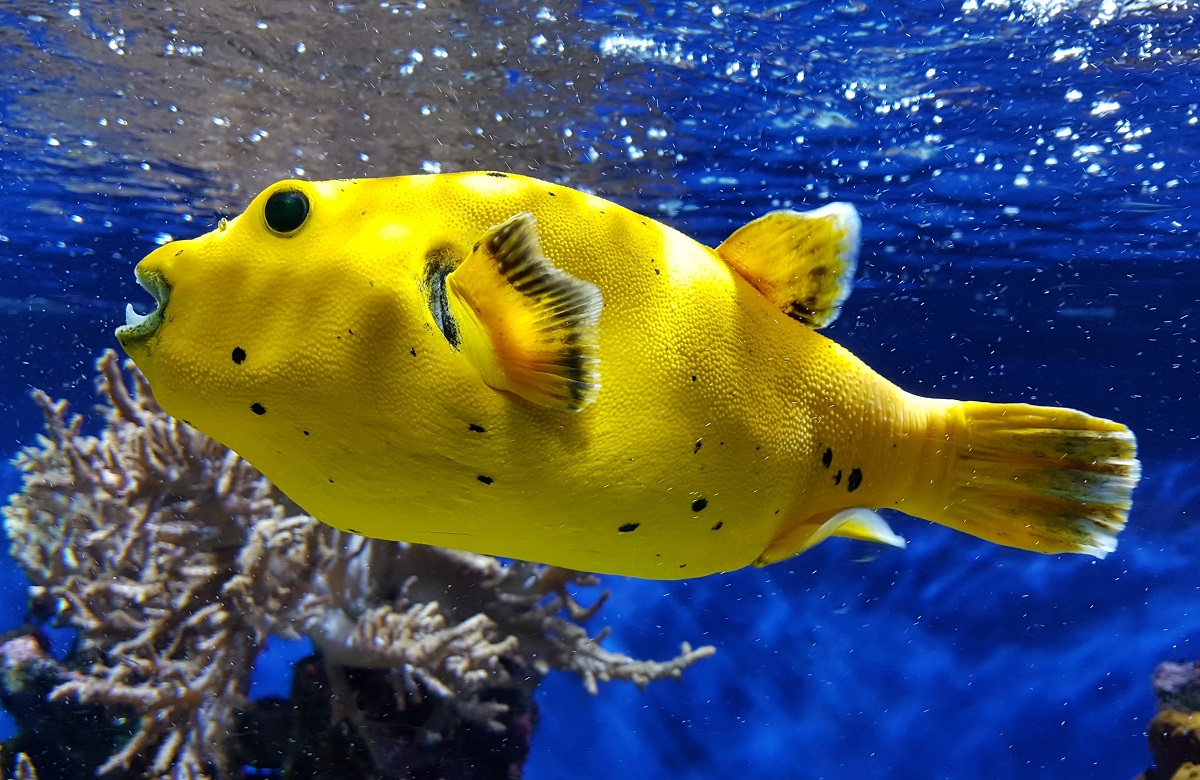Looking for an unusual addition to your marine aquarium? Maybe a pufferfish is the right choice for you. There’s a reason so many aquarists like to keep pufferfish as a pet: these strange-looking fish are not just known for their ability to inflate, but also for their high intelligence levels and interesting behavior.
Keep reading for a list of five of our favorite pufferfish to keep as a pet!

Stars and stripes puffer (Arothron hispidus)
This species is also known as the white-spotted puffer, which is not surprising given its polka-dot pattern. The stars and stripes puffer is a pretty large fish, reaching a maximum length of 18”. This means it’s unsuitable for aquariums under 250 gallons.
Make sure to use plenty of live rock to create an interesting environment for your stars and stripes puffer to explore. Keep in mind that this is not a community fish, nor is it reef safe: you’re better off keeping it in a single species set-up.
You can read more in the stars and stripes puffer care guide!

Valentini puffer (Canthigaster valentini)
Looking for a puffer species that doesn’t require a beast of a tank to thrive? Toby puffers from the genus Canthigaster, like the Valentini puffer, would be a great choice. Also known as the saddled puffer or sharpnose puffer, this species only reaches about 4.5” in length, making it a lot more manageable than many other pufferfish.
Your Valentini puffer will need an aquarium of 30 gallons or up. It’ll feed on small invertebrates and is best for a fish-only aquarium, where they do relatively well with a broad range of tankmates. Do make sure to avoid anything with long, flowy fins!
You can read more in the full Valentini puffer care guide.
Did you know? You should always keep a puffer underwater, even when catching it. If they get startled and inflate themselves with air rather than water, they don’t always survive.

Dog faced puffer (Arothron nigropunctatus)
Like the previously discussed stars and stripes puffer, the dog faced puffer is a member of the genus Arothron. This species stays a bit smaller than its cousin, though, with a maximum size of around 13” in length. Still, you’ll need an aquarium of 100 gallons or more to keep yours happy and healthy.
Despite its menacing appearance (you don’t want to get your fingers near those teeth!), the dog faced puffer is considered to be relatively peaceful. It can be kept with other larger species and is even considered one of the less destructive pufferfish when it comes to reefs.
Read more in the dog faced puffer fish care guide!

Guineafowl puffer (Arothron meleagris)
Want a pufferfish as a pet and have some space to spare? The guineafowl or golden puffer, Arothron meleagris, is the largest species on this list. It grows to a whopping 20” in length and requires an aquarium of at least 250 gallons to thrive.
Unsurprisingly given its size and menacing appearance, this is a true predator that will actively hunt invertebrates and eat anything it can get its beak on. It’s also absolutely not reef safe, being a corallivore, or a coral eater.
So why do people keep the guineafowl puffer then? They’re intelligent, can form a bond with their owners and not unimportantly, they’re pretty spectacular to look at. Standard guineafowl puffers are blue with white spots, but there’s also a bright yellow version with black spotting (pictured at the top of this article).
Did you know? Pufferfish are messy eaters that produce a lot of waste. Make sure you’ve got a powerful filtration system in place if you’d like to keep one!

Blue spotted puffer (Canthigaster solandri)
Looking at the blue spotted puffer, you’d almost think this species glows in the dark! The most flamboyant fish on this list, it sports a rust-colored body with electric blue patterning. With a maximum size of 5”, this one is suitable for aquariums of 50 gallons or up.
Reports on the blue spotted puffer’s reef compatibility are varied, but we’d recommend being cautious about introducing them into a tank with prized corals. A fish-only set-up is the best option if you don’t want to take any risks! Invertebrates will be eaten if the puffer can find them, although fish should generally be left alone.

Conclusion
A colorful marine aquarium with one of these amazing pufferfish is a joy to see. Aquarists love keeping pufferfish as a pet due to their intelligence, curiosity and amazing hunting behavior!
Dreaming of your own aquarium and keeping a pufferfish as a pet? Shoot us a message here! FantaSEA Aquariums designs, sets up and maintains salt- and freshwater aquariums for our clients.




